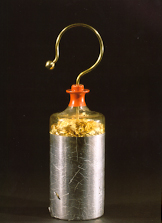
36.8 x 10.4
Glass, gold leaf, tin leaf and brass
CAT. 1851 : 52.L.II
Dez garrafas de Leyde de diversas dimensoens sendo uma muito maior que as outras. - Vaõ em J.I.
Ten Leyden jars of varying sizes with one much larger than the others.
- Go in J.I.
Leyden jars are electric condensers comprising a glass jar completely coated on the outside by tin leaf, from the bottom of the jar to about 4/5 of its height.
The interior of the jar contains gold leaves, which almost fill it, hiding a metal rod which passes through a cork stopper. The tin leaf is called the outer shield and the gold leaf is the internal shield.
It was with this type of jar that the electric condenser was discovered in 1746. Counes, a pupil of Musschenbroek, was repeating his teacher's experiments with the aim of electrically charging water in a glass vessel held in his hand when he felt a violent shock on withdrawing an iron wire whose end was submerged and which was supposed to charge the water. A condenser was thus obtained, with the water being the internal shield and the hand holding the jar, the external one. This interesting episode was told by Musschenbroek to Réaumur, who passed it on to 's Gravesande, Winkler and Nollet. It started a series of investigations.
If the internal shield is electrically linked to the metal conductor of an electrostatic machine, with its outer shield connected to the ground, a violent electrical discharge results when a curved piece of articulated brass, with insulating glass handles, is brought near in such a way that one of its ends touches the outer shield, while the other end is close to the sphere of the condenser that communicates with the internal shield. This discharge is due to the distribution of opposite charges between the internal and external shields.
Leyden jars were very important to the development of experimental methods in Physics in the 19th century.
Sigaud de la Fond, Joseph-Aignan, Description et Usage d'un Cabinet de Physique Expérimentale, Paris, 1775, Vol. II, Pl. XXIV.
Daguin, Pierre-Adolphe, Traité Élémentaire de Physique Théorique et Expérimentale, Paris, 1878, Vol. III, nº. 1663-1664.
Ganot, A., Traité Élémentaire de Physique, 19th edition, Paris, 1884, p. 864, Fig. 772.